The goal of infection control is to prevent the spread of infections to staff and patients. Two key measures for both visitors and staff are:
- Respiratory Hygiene
- Hand Hygiene
 Respiratory hygiene means:
Respiratory hygiene means:
- Covering nose and mouth when coughing and sneezing.
- Using tissues and masks to contain respiratory secretions.
- Disposing of tissues and masks in the waste after use.
- Performing hand hygiene after contact with respiratory secretions and contaminated objects/materials.
- Encouraging coughing persons to sit at least 3 feet away from others in common waiting areas.
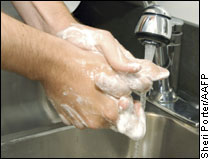 Hand hygiene means:
Hand hygiene means:
Handwashing with soap and water, and drying the hands OR using an alcohol-based hand gel.
Make sure alcohol gels dry before touching surfaces to avoid damage to surfaces, carpets, and doors. Also, burns have been reported when staff or visitors light a cigarette with wet alcohol gel on the hands.*
Alcohol gels are effective for rapid hand cleansing between patients when hands are visibly clean. It kills some types of microorganisms, including Acinetobacter, MRSA, HIV, hepatitis, and VRE. It is less effective at killing other organisms, such as C.difficile, Pseudomonas, prions, and other hard-to-kill pathogens.
Washing at the sink is still necessary when the hands are soiled, when working with patients in Contact Precautions, and after repeated use of the alcohol gel.
Alcohol gels should not be used to clean equipment, items, or surfaces; they damage surfaces.
Hand hygiene at HMC is expected, at a minimum:
- Before and after touching patients
- After using the restroom
- Before eating
- After removing gloves
It is important to keep your hands in good shape by having intact skin on your hands. Use lotions and creams to prevent dryness or irritation. Consult Employee Health or your MD for dermatitis and do not touch patients if you have signs of dermatitis or infection on your hands until Employee Health has ruled out conditions that could harm patients.
Staff who provide direct or indirect patient care should not wear artificial nails or extenders.
At Harborview, staff should always use gloves when they may touch body fluids, open skin and mucus membrane. Gloves are also routinely used as a part of Contract Precautions. Sterile gloves are used for invasive procedures.
*Hand Rub-Associated Fire Incidents During 25,038 Hospital-Years in German. Axel Kramer, Gunter Kampf. Infection Control and Hospital Epidemiology. Vol. 28, Number 6. June 2007 p. 745.
TB is increasing in the region!
Harborview had 40 lab confirmed TB patients in 2007 (30 inpatients, 10 outpatients.) King County had 161 patients, a 30 year high. About 12% of the TB cases in King County were drug resistant to at least one TB medication. King County's rate of TB is higher than the national rate (8.6 vs. 4.9 per 100,000 residents), so keep TB in mind when evaluating patients with respiratory
symptoms.
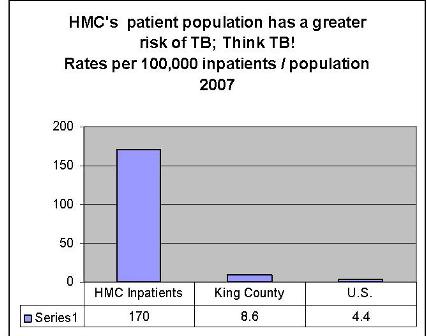
If a patient presents with a cough of several weeks duration and is foreign borne, consider isolation. Foreign born patients, especially those from the Marshall Islands, Vietnam, Somalia, Ethiopia, India are at a greater risk for TB.
Public Health -Seattle & King County reminds us that it is important to know the HIV status of every TB patient; encourage testing.
Patients with TB may NOT be restrained to keep them in the isolation room or prevent them from leaving.
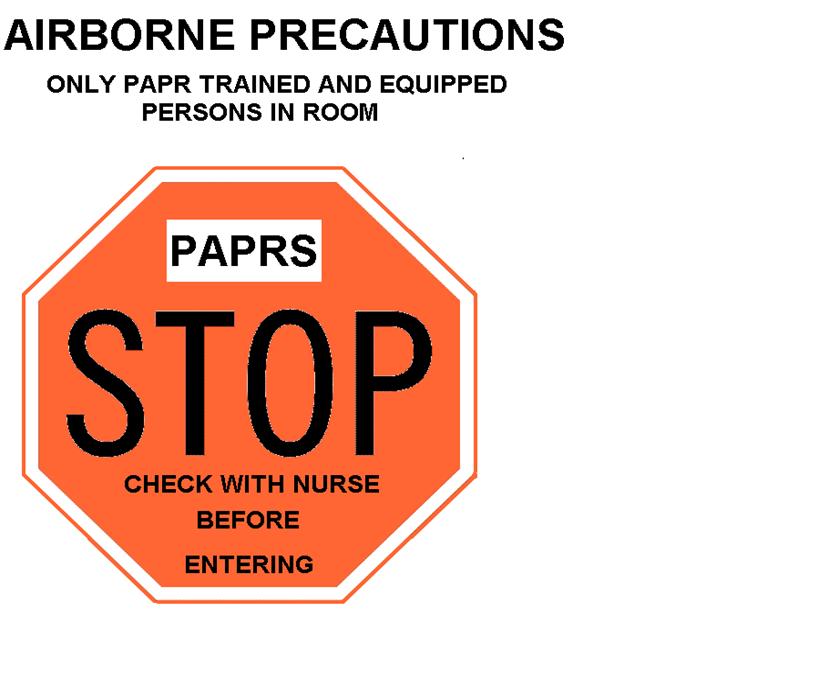
To prevent exposure to TB:
- Place coughing patients, suspected of TB immediately into a private, negative pressure room.
- Post the AIRBORNE STOP sign on the door (illustrated above).
- Wear PAPRs (Powered Air Purifying Respirators) to enter the room of a patient in Airborne Precautions
- If it is necessary for the patient to leave the room, mask the patient with a surgical mask.
- Always wear a PAPR during bronchoscopy, even for patients not in isolation.
Annual TB screening is required for ALL personnel working in patient care areas. Your screen must be in 2007 to be valid.
Screen for persons with negative PPDs:
- If your skin test has not reacted in the past, you will need a PPD skin test. The test must be evaluated between 48 and 72 hours after placement and reported to Employee Health Service.
Screen for persons with positive PPDs:
- If your skin test has reacted, and we have evidence of a negative chest x-ray, you must complete an annual TB symptoms questionnaire.
TB screening is available through Employee Health Services, located at 7EC room 02 during the following times: 7:15 a.m. to 4:30 p.m. M, W, Th, and F. 7:15 a.m. to 12:00 p.m. on Tuesday.
HMC uses Powered Air Purifying Respirators (PAPR) with High Efficiency Particulate Air (HEPA) filters. Employees must be trained for respirator wear. The following steps shall be followed every time the respirator is used.



Step One Step Two Step Three
Step One: Inspect the respirator unit, air tube and hood for damage. Only use if all pieces are intact and in good working order. Immediately take malfunctioning equipment out of service and contact Clinical Engineering.
Step Two: Test air flow with unit ON. The airflow indicator must float above the lower band on the test cup.
Step Three: Put on the hood. There should be good airflow over the face, exiting below the chin. You are now ready to enter the isolation area. When finished, exit the room.
Step Four: Remove hood and turn off unit outside of contaminated area. Inspect equipment, clean if necessary.
Step Five: Return power unit to charger, and your personal hood to the storage area. Hoods used by more than one individual must be cleaned after use.
Helpful Numbers Regarding PAPRs
To report equipment failures, call Clinical Engineering at 4-3496.
To purchase hoods or checkout PAPR units, call Medical Stores at 4-8384.
To report exposures or concerns at any time, call Employee Health at 4-3081, or Epidemiology/Infection Control at 4-9560.
We are continuously analyzing what devices and procedures are involved in exposures. The Product Evaluation Committee evaluates new devices. If you know of a device you would like evaluated:
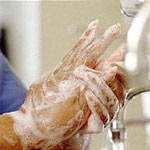
- Wash area immediately.
- Seek care within 2 hours at Employee Health or the Emergency Department.
- Verbally report the exposure to Employee Health at 4-3081.
- Document the incident with your supervisor.
- Following employee exposure, patient consent for testing can be obtained and arranged by Employee Health or the Emergency Department. Counseling is also available.
- Hepatitis B, Hepatitis C, and HIV can ONLY be tested for after consent is obtained.
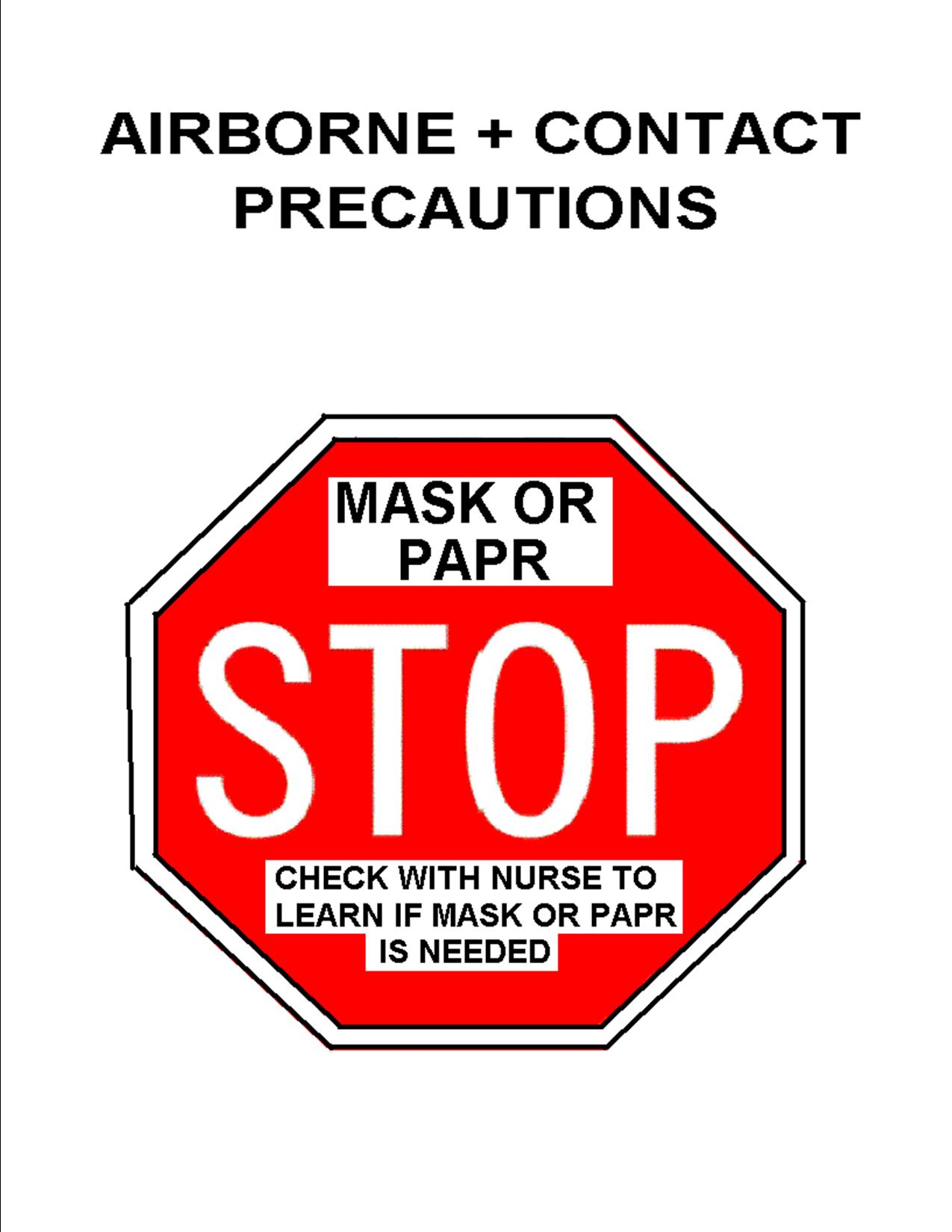
Patients at HMC suspected of having very unusual and/or potentially dangerous syndromes such as pandemic influenza ("bird flu"), a bioterrorism agent, SARS or an unknown and new syndrome should be placed immediately in a private, negative pressure, isolation room. All persons entering the room must sign in and wear gowns, gloves and PAPRs.
Post the Airborne and Contact Precautions Sign, for example, for
- Influenza-like illness in a traveler from areas with avian influenza who also had contact with bird markets or flu patients
- Unexplained critical respiratory illness that might have a new etiology
- Highly pathogenic avian influenza
- SARS
- Smallpox,vaccinia, monkeypox
- Viral hemorrhagic fevers
The charge nurse should ensure that Dr. Dellit, the Infection Control Medical Director, or Infection Control is notified immediately.
Unexplained critical illness or death should be reported to the Health Department, PH-SKC's 24 hour line at 206-296-4774.
For large numbers of cases, HMC Administration may activate the Disaster Plan.
During construction and renovations, there could be conditions that might lead to infection problems in patients. These conditions include:
- Uncontained dust
- Air blowing out from a construction zone
- Water leaks
- Water soaked walls growing mold
If you see any of these during construction and renovation projects, please contact your manager, the shift engineer, or Infection Control.
You can learn more about infection control at HMC by linking to http://depts.washington.edu/ictrain/ and through the HMC intranet.
Epidemiology/Infection Control office: 4-9560
Congratulations, you have completed the reading section of Module 3.
Next, click on "Take the Quiz" at the bottom of this screen.
Once you are finished with the quiz, you will be directed to Module 4.
Last modified: 5/07/2008 11:46 AM